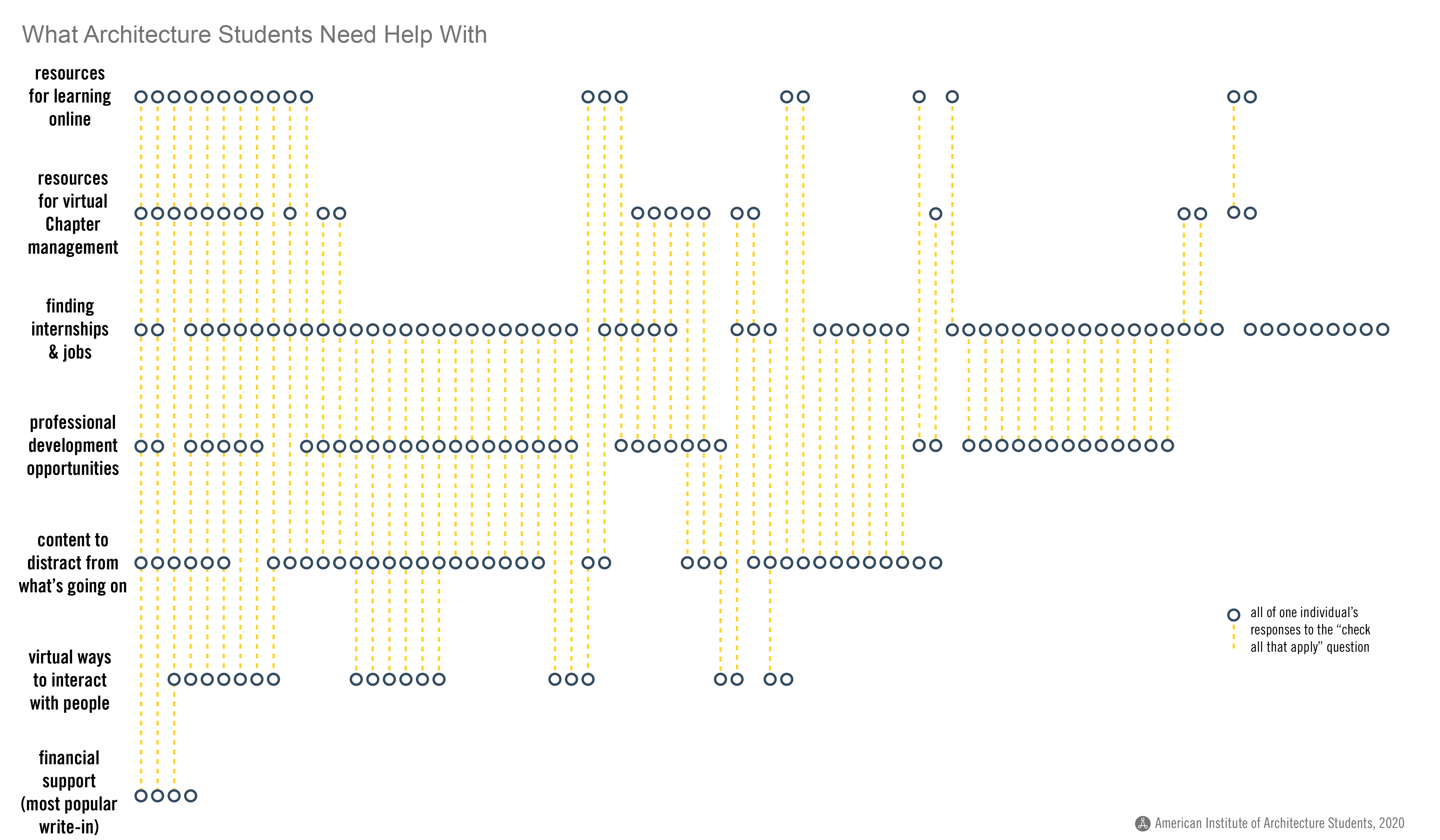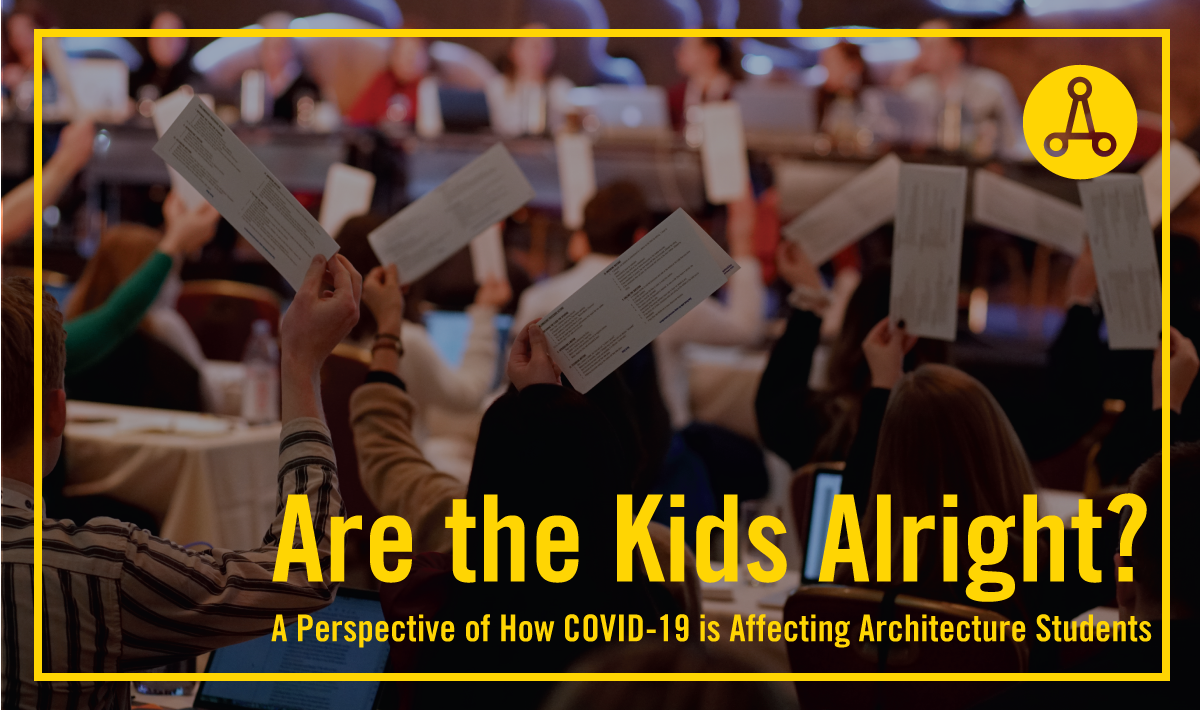Are the Kids Alright?
A Perspective of How Covid-19 is Affecting Architecture Students
The coronavirus pandemic has had a domino effect across the education system and all those in it. As schools across the country began to close, faculty hastily shifted to teaching online, those with homes to go back to were sent away from campus, dorm rooms still full of furniture and personal items were abandoned, parents made more room for coexisting with their children, and we all began counting down and adding up the days in our new quarantine-like lifestyles. While we are all united in our current struggle, no two individuals have been affected in the same way, and college students are arguably getting discombobulated the fastest and most profoundly. Endless articles and authorities have indicated that whatever the future holds for this already perilous demographic is too unstable to predict. In order to better serve students during their time of need, the American Institute of Architecture Students (AIAS) released a survey in late-March to identify the primary concerns of architecture students at this time and how the health crisis has affected their outlook.

Professional Opportunities & Financial Stability
The field of architecture, while incredibly worthwhile, is a difficult profession to join. People who are privileged enough to put themselves through architecture school are still not licensed architects, and recent graduates are encouraged by society to immediately begin the Experience step in their journey. Any additional costs and slight inconveniences are hopefully well worth the joys of a new job in a long-sought-after (and long-to-be-paid-for) career. By nature of our education, architecture students are led to believe that they can earn such employment through the achievements and success that we’ve accumulated while pursuing our degrees.
However, like almost all job fields in today’s economy, students are graduating as we speak and are not currently able to secure fulfillment or the support needed to pay back what they borrowed in order to go to school. Similar to how the hundreds of freshmen that walked into their first “Intro to Architecture” class were whittled down over the years to a graduating class of 30 or 40, feasibility and fear will reduce the incoming workforce to fractions and fragments. Those who are financially and culturally underserved – often without mentors or connections to the profession, and who come from schools you haven’t heard of – are the ones we’ll lose first.
Whether or not we’ll be able to empower them and lasso their exponential energy, creativity, talent, diversity, and versatility back to the difficult profession of architecture remains to be seen so far. As a profession, we have to ask ourselves what we can do today to put eager and educated students to work tomorrow, regardless of how uncertain the days ahead of us may be. The economic reasons are obvious, but the empathetic necessity is not often discussed. Another little-mentioned but very true fact of the matter: any attempted solutions that do not consider and speak to the “least” of us, cannot be defined as successful. We absolutely must assuage the fears of those who are most vulnerable, or be prepared to face the consequences of another lost generation and another setback in the equity our profession is pursuing.
Studio Work & Mental Health
Recent conversations about Studio Culture and Learning & Teaching Culture have done a lot to raise awareness about and ultimately mitigate the ill effects of toxic environments that exist in some architectural curricula. With finals, thesis presentations, and capstone projects coming to a point, this time of year is even more stressful for students and faculty – and we often see a drop in AIAS Chapter and community engagement in congruence with a spike in unhealthy behaviors toward the end of the spring semester.
The transition to online learning has seen a dramatic shift in how we conduct classes and continue to train architects and designers. On one hand, desk crits, and other formerly informal methods of reviewing work, become more serious and less constructive without the ease of an in-person environment and the friendly debrief or pep-talk with a nearby peer. On the other hand, being forced to put more effort into how we communicate, drawing more, and working harder to collaborate intentionally are a few of many silver-linings. On top of this sudden alteration to life that was already out of our control, the pandemic has also turned time spent not doing schoolwork into a twilight zone of new behaviors in an unchanging scene. The lights at the ends of our tunnels were once punctuated with social gatherings, going outside and shutting off the screens, day-long recovery naps, and graduation ceremonies; and now students must cope with ellipses of patting our own backs, unspoken goodbyes, and more screens.
The current circumstances are enough to drive even the most emotionally stable of us to a problematic level of anxiety if left unchecked, and quite frankly, it already has. If any of these patterns carry over into our “new normal”, young people will have to try harder to connect not only virtually with classmates but also in-person with our families and those around us. While it has always been a struggle to summon energy when we feel at our lowest, this latest edition of our college experience will require as serious and intentional of a commitment to our mental health as we automatically give to our academic studies.

Serving Communities & Ourselves
People who grow up to be architects are often either raised, trained, or designed from birth to care about their communities and the greater public. This is emphasized in some college curricula that heavily focus on public-interest design, pro-bono projects, and work in underserved communities. Many AIAS Chapters also participate in our AIAS Freedom by Design Program (FBD) that empowers students to make use of their learned skills by serving their communities through design-build or engagement projects and spreading awareness of the benefits and abilities of architecture and design.
It is no surprise then, how the current crisis has motivated much of this generation and our profession to, in the midst of their own turmoil, nevertheless look around at how they can help others. Many students and faculty across the country are occupying their time and available resources with efforts to mitigate the current debilitating shortage of masks, ventilator parts, and other PPE in the healthcare system. Personal and school-loaned 3D Printers are working around the clock to provide reusable pieces for hospitals and grocery stores, and fabrics are being up-cycled into washable masks that are available for community use. The same attention to craft that we were trained to bring to our work is equally detailed, but taken even more seriously now that the stakes are life and death.
As we all wonder how the pandemic will influence the profession from economic and design standpoints, it’s also worth considering how the current crisis will amend our definition of an architect. A level of scope that was once seen as ambitious is now not only within reach, but is imperative. Though we spend a lot of time debating best practices for public outreach and thinking of ways that we can communicate to non-architects how valuable our skillset is, it seems that along the way, we’ve forgotten to convince ourselves. Now, as community planners, ad-hoc hospital designers, and experienced makers, public trust and internal confidence in our abilities is on the rise. If the importance of our role in society becomes more egregious than ever during times of crisis, imagine what we could do during prosperous times of peace.
AIAS at Work
In response to this survey and to our students’ discussions about what they’re going through, the AIAS has enacted a few fast-paced resources as well as “big picture” tactics to assist our members. Our initial compilation of resources and support immediately addressed the tenets of our organization – leadership, design, and service – through the lens of surviving a health crisis in all areas of student life. Our goal was to create a one-stop-shop for a variety of resources and crowd-sourced information about Chapter continuity, Skills and inspiration, Professional development, and Opportunities for serving ourselves and others. Almost every AIAS National Committee took their specific expertise and interests a step further by writing articles, recording tutorials, and hosting events that dived deeper into alleviating stress and sharing best practices for getting through these tough times. Based on great ideas from our membership, we’re making sure to highlight the positive aspects of life that are still going on by facilitating more casual and empathetic virtual interactions and by celebrating our graduates and their achievements. The AIAS would also like to thank our collateral and allied-architectural organizations who have already helped to address some of the earliest obstacles that students are encountering.
The AIAS understands that there are a myriad of needs in the matriculation of every student, and that there is no easy or segregated answer to “fixing” these kinds of issues. However, as long as hardships for architecture students exist, the AIAS will actively work to minimize and overcome them, both topically in the day-to-day lives of students, and at their systematic source. It goes without saying that such lofty goals cannot be tackled alone.

Simply put, the kids are not alright. We’re doing our best, just like everyone else is, but inherent to our status as architecture and design students, the circumstances in our lives are extenuated. As worried as we are about ourselves, we are equally anxious for our families, friends, and for those who put themselves at risk in order for us to stay safe. We’re not oblivious to the multi-layered hardships that professionals and architects are going through, but we do ask that our generation and our struggles are not forgotten or dismissed. And let’s be even more clear: we are not looking for one person, one webinar, one institute, or one employer to have all the answers. We are seeking a profession full of people who care enough to help us build the answers that bring us back to a passion that we don’t want to leave. Pre-existing conditions of instability in our field are already inextricably connected to each other and have only been compounded by the pandemic; our solutions will have to be as quick as they are sustainable, and as multifaceted as they are unique. These are the kinds of problems we were trained to solve, and we’re ready to help solve them.
##
This article was compiled from responses to the survey, “AIAS COVID-19 Vibe Check“, and written by Sarah Curry, AIAS
The American Institute of Architecture Students is a non-profit, student-run organization dedicated to programs, information and resources on issues critical to architecture and the experience of education. For more information, visit www.aias.org or call (202)808-0075.










